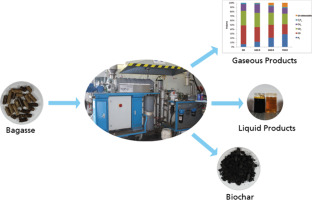当前位置:
X-MOL 学术
›
Fuel Process. Technol.
›
论文详情
Our official English website, www.x-mol.net, welcomes your feedback! (Note: you will need to create a separate account there.)
Integrated thermo-catalytic reforming of residual sugarcane bagasse in a laboratory scale reactor
Fuel Processing Technology ( IF 7.5 ) Pub Date : 2018-03-01 , DOI: 10.1016/j.fuproc.2017.11.020 Ejaz Ahmad , Nils Jäger , Andreas Apfelbacher , Robert Daschner , Andreas Hornung , K.K. Pant
Fuel Processing Technology ( IF 7.5 ) Pub Date : 2018-03-01 , DOI: 10.1016/j.fuproc.2017.11.020 Ejaz Ahmad , Nils Jäger , Andreas Apfelbacher , Robert Daschner , Andreas Hornung , K.K. Pant

|
Abstract The objective of present study was to demonstrate efficient conversion of residual sugarcane bagasse by thermo-catalytic reforming (TCR®) into fuels and high-value products in a laboratory scale 2 kg/h unit. None of the toxic or non-toxic chemicals and solvents was employed during the process, thus minimizing negative environmental effects. In addition, a detailed study on the composition of bio-oil using GC–MS, FT-IR and on the properties of biochar using Raman spectroscopy, SEM, SEM-EDS, TEM, TEM-EDX and BET surface analyzer have been reported for the first time for TCR® process. At optimum operating parameters, ~ 57.0 wt% gaseous products, 23.5 wt% biochar, 15.5 wt% aqueous phase and ~ 4 wt% bio-oil were obtained. The hydrogen content and higher heating value (HHV) of the gaseous product were measured up to 37 vol% and 16.40 MJ/kg, respectively. The bio-oil was naturally separable from liquid phase due to gravity without application of an extracting solvent. Moreover, the bio-oil had very low water (2.6 wt%) and oxygen (10.2 wt%) content as well as HHV of 32.11 MJ/kg. Furthermore, biochar produced from TCR® possessed excellent structural and morphological properties, thereby showing potential for several applications in catalysis, soil improvement and for various other purposes. The BET surface area and micropore surface area of biochar were measured 93.144 m2/g and 90.654 m2/g, respectively whereas, the t-plot micropore volume was measured 0.0487 cm3/g.
中文翻译:

实验室规模反应器中残留甘蔗渣的集成热催化重整
摘要 本研究的目的是证明通过热催化重整 (TCR®) 以实验室规模 2 kg/h 单位将残余甘蔗渣有效转化为燃料和高价值产品。在这个过程中没有使用任何有毒或无毒的化学品和溶剂,从而最大限度地减少了对环境的负面影响。此外,已经报道了使用 GC-MS、FT-IR 对生物油的组成以及使用拉曼光谱、SEM、SEM-EDS、TEM、TEM-EDX 和 BET 表面分析仪对生物炭特性的详细研究。第一次使用 TCR® 工艺。在最佳操作参数下,获得了约 57.0 wt% 的气态产品、23.5 wt% 的生物炭、15.5 wt% 的水相和约 4 wt% 的生物油。测得气态产品的氢含量和较高的热值 (HHV) 高达 37 vol% 和 16.40 MJ/kg,分别。由于重力,生物油可自然地与液相分离,而无需使用萃取溶剂。此外,生物油具有非常低的水 (2.6 wt%) 和氧气 (10.2 wt%) 含量以及 32.11 MJ/kg 的 HHV。此外,由 TCR® 生产的生物炭具有出色的结构和形态特性,因此显示出在催化、土壤改良和各种其他用途方面的多种应用潜力。生物炭的 BET 表面积和微孔表面积分别测量为 93.144 m2/g 和 90.654 m2/g,而 t-plot 微孔体积测量为 0.0487 cm3/g。2 wt%) 含量以及 HHV 为 32.11 MJ/kg。此外,由 TCR® 生产的生物炭具有出色的结构和形态特性,因此显示出在催化、土壤改良和各种其他用途方面的多种应用潜力。生物炭的 BET 表面积和微孔表面积分别测量为 93.144 m2/g 和 90.654 m2/g,而 t-plot 微孔体积测量为 0.0487 cm3/g。2 wt%) 含量以及 HHV 为 32.11 MJ/kg。此外,由 TCR® 生产的生物炭具有出色的结构和形态特性,因此显示出在催化、土壤改良和各种其他用途方面的多种应用潜力。生物炭的 BET 表面积和微孔表面积分别测量为 93.144 m2/g 和 90.654 m2/g,而 t-plot 微孔体积测量为 0.0487 cm3/g。
更新日期:2018-03-01
中文翻译:

实验室规模反应器中残留甘蔗渣的集成热催化重整
摘要 本研究的目的是证明通过热催化重整 (TCR®) 以实验室规模 2 kg/h 单位将残余甘蔗渣有效转化为燃料和高价值产品。在这个过程中没有使用任何有毒或无毒的化学品和溶剂,从而最大限度地减少了对环境的负面影响。此外,已经报道了使用 GC-MS、FT-IR 对生物油的组成以及使用拉曼光谱、SEM、SEM-EDS、TEM、TEM-EDX 和 BET 表面分析仪对生物炭特性的详细研究。第一次使用 TCR® 工艺。在最佳操作参数下,获得了约 57.0 wt% 的气态产品、23.5 wt% 的生物炭、15.5 wt% 的水相和约 4 wt% 的生物油。测得气态产品的氢含量和较高的热值 (HHV) 高达 37 vol% 和 16.40 MJ/kg,分别。由于重力,生物油可自然地与液相分离,而无需使用萃取溶剂。此外,生物油具有非常低的水 (2.6 wt%) 和氧气 (10.2 wt%) 含量以及 32.11 MJ/kg 的 HHV。此外,由 TCR® 生产的生物炭具有出色的结构和形态特性,因此显示出在催化、土壤改良和各种其他用途方面的多种应用潜力。生物炭的 BET 表面积和微孔表面积分别测量为 93.144 m2/g 和 90.654 m2/g,而 t-plot 微孔体积测量为 0.0487 cm3/g。2 wt%) 含量以及 HHV 为 32.11 MJ/kg。此外,由 TCR® 生产的生物炭具有出色的结构和形态特性,因此显示出在催化、土壤改良和各种其他用途方面的多种应用潜力。生物炭的 BET 表面积和微孔表面积分别测量为 93.144 m2/g 和 90.654 m2/g,而 t-plot 微孔体积测量为 0.0487 cm3/g。2 wt%) 含量以及 HHV 为 32.11 MJ/kg。此外,由 TCR® 生产的生物炭具有出色的结构和形态特性,因此显示出在催化、土壤改良和各种其他用途方面的多种应用潜力。生物炭的 BET 表面积和微孔表面积分别测量为 93.144 m2/g 和 90.654 m2/g,而 t-plot 微孔体积测量为 0.0487 cm3/g。



























 京公网安备 11010802027423号
京公网安备 11010802027423号